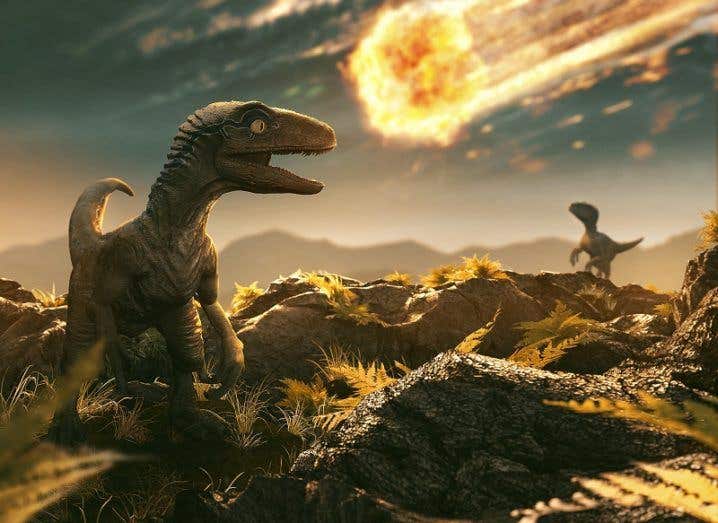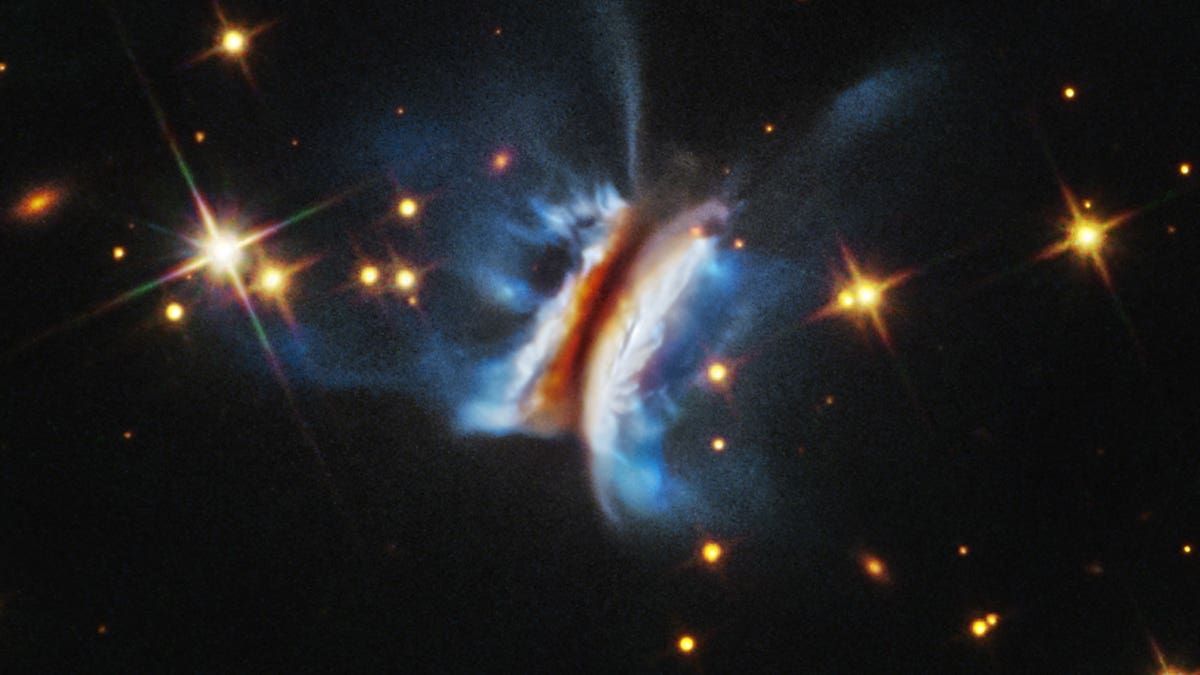Scientists discover fragment of the asteroid that killed the dinosaurs
Some 66 million years ago, on a fateful day etched in Earth’s history, a colossal 7.5-mile-wide space rock hurtled towards our planet

[Nov. 16, 2023: JD Shavit, The Brighter Side of News]
A fateful day some 66 million years ago, a 7.5-mile-wide (12 kilometer) space rock slams into Earth. (CREDIT: AdobeStock)
Some 66 million years ago, on a fateful day etched in Earth's history, a colossal 7.5-mile-wide (12-kilometer) space rock hurtled towards our planet. This catastrophic collision marked the beginning of a chain of events that ultimately spelled doom for the age of dinosaurs.
NASA has described this discovery as nothing short of "mind-blowing." In a captivating TV special titled "Dinosaur Apocalypse," the unfolding story of this cataclysmic event is reconstructed using freshly unearthed evidence, offering a glimpse into the unfortunate day that changed the course of life on Earth.
Unearthed Amber and Time-Capsule Fossils
Among the extraordinary finds that have emerged from a unique fossil site in the Hell Creek Formation in North Dakota, perhaps the most astonishing is a tiny fragment of the asteroid itself, encased in amber. This discovery is a testament to the remarkable preservation of remnants from the momentous asteroid impact that brought the dinosaur era to an abrupt end.
Related Stories
The fossils uncovered at this site are a true testament to the cataclysmic moment in Earth's history. They include fish that had inhaled debris ejected during the asteroid strike, a turtle impaled with a stick, and a leg that could have belonged to a dinosaur that bore witness to the asteroid's devastating impact.
Narrated by the legendary Sir David Attenborough, the "Dinosaur Apocalypse" documentary takes viewers on a journey with paleontologists as they excavate these rare fossils and bring to life the scenes of the past, using cutting-edge computer-generated imagery (CGI).
The Heart of Discovery: Tanis in North Dakota
The core of this remarkable documentary revolves around the findings made at a specific section of the Hell Creek Formation in North Dakota known as Tanis. Researchers suspect that Tanis holds the key to uncovering a mass graveyard of animals that perished soon after the asteroid struck. Julia Cort, a NOVA co-executive producer, expressed her excitement, saying, "We're able to look over the shoulders of paleontologists uncovering some of the rarest fossils ever found in North America — perhaps in the world — that if confirmed, could help illuminate the most dramatic single day in the history of the planet."
Over the span of three years, the documentary delves into the painstaking work of Robert DePalma, a doctoral student at the University of Manchester in England, and his dedicated team. In 2012, they embarked on an ambitious mission at Tanis, more than 2,000 miles away from the Chicxulub impact crater created by the asteroid off the coast of Mexico. Their initial discoveries at Tanis convinced DePalma that this site held unparalleled evidence of the events that led to the dinosaurs' extinction.
What sets Tanis apart is the treasure trove of well-preserved fish fossils that DePalma and his team unearthed. These fish appeared to have been buried alive by sediment that was displaced as a massive body of water surged up the interior seaway, triggered by the asteroid's impact. Unlike the gradual onset of tsunamis, these surges, known as seiches, occurred instantaneously following the colossal asteroid's crash into the sea.
Tanis - The ancient Egyptian capital. (CREDIT: Einsamer Schütze - CC BY-SA 3.0)
DePalma is confident that the fish met their demise within just an hour of the asteroid impact, rather than succumbing to the massive wildfires or the nuclear winter that followed in the subsequent days and months. The telltale signs lie in the discovery of "impact spherules," small fragments of molten rock ejected from the crater and crystallized into a glass-like material, found lodged in the fish's gills. Additionally, the analysis of the fish fossils indicates that the asteroid struck during the spring season.
DePalma passionately describes the accumulation of evidence, stating, "One piece of evidence after another started stacking up and changing the story. It was a progression of clues like a Sherlock Holmes investigation. It gives a moment-by-moment story of what happens right after impact, and you end up getting such a rich resource for scientific investigation."
While the discoveries at Tanis present a compelling narrative, not all experts are entirely convinced of the precise timing of the Thescelosaurus dinosaur's death, as featured in the documentary. Some are reserving judgment until all the findings are thoroughly examined and published in peer-reviewed journals. The scientific community, known for its rigorous scrutiny, seeks to ensure that the evidence stands up to meticulous scrutiny before accepting the narrative presented in "Dinosaur Apocalypse."
The story of the asteroid that forever altered the course of life on Earth is both awe-inspiring and humbling. Through the lens of "Dinosaur Apocalypse," viewers are given a unique opportunity to witness the relentless pursuit of knowledge by paleontologists like Robert DePalma and his team. These dedicated scientists are unearthing fossils that offer a glimpse into the last moments of the dinosaurs and the immediate aftermath of the cataclysmic asteroid impact.
While questions and skepticism persist within the scientific community, the discoveries at Tanis hold immense potential to shed light on the events of that fateful day 66 million years ago. As researchers continue to analyze the evidence and subject it to rigorous peer review, our understanding of this pivotal moment in Earth's history may soon become even clearer. The "Dinosaur Apocalypse" documentary stands as a testament to the enduring curiosity of scientists and the ever-evolving story of our planet's past.
For more science stories check out our New Discoveries section at The Brighter Side of News.
Note: Materials provided above by The Brighter Side of News under a Creative Commons license. Content may be edited for style and length.
Like these kind of feel good stories? Get the Brighter Side of News' newsletter.



